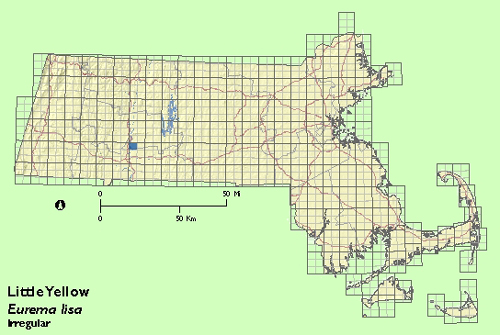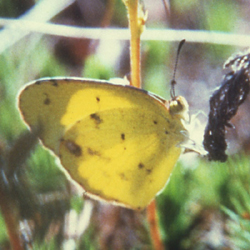Find a Butterfly
Little Yellow
Eurema lisa
Named
Boisduval and LeConte, 1829

Taxonomy & Nomenclature
Little Sulphur in some works.
Identification
Wingspan: 1 - 1 1/2". The smallest "yellow" in New England. The combination of its small size, clear chrome yellow coloration above and below, and the pattern of its black wing margins and underwing spotting distinguish it easily from similar species. Compare Clouded Sulphur and Sleepy Orange.
Distribution
A largely tropical species, residing year round from Costa Rica north through Mexico and the Caribbean to the southeastern United States from east Texas to southeastern Virginia. An abundant species throughout most of its breeding range, the Little Yellow disperses northward each summer and fall, frequently reaching the northern Great Plain states and southern Canada east to Nova Scotia. It is not able to overwinter north of about 40 degrees N. Lat., but individuals arriving northward early enough in the season and finding a supply of an appropriate food plant (see below), are able to produce a single brood. The species has reproduced in southern Connecticut but so far cannot survive the winter. It reaches the rest of New England only irregularly, becoming increasingly rare northward.
Status in Massachusetts
Irregular summer and fall visitor from the South. Only two records from the atlas period (1986-90). However, historically, it has occurred throughout much of the state (see map) and occasionally appears in good numbers. Scudder thought it "tolerably common" on Nantucket on one occasion, and Vladimir Nabokov reported that during "the warm autumn of 1946...the Little Sulphur (was) abundant throughout the fall along the railway line near Wellesley...". According to Farquhar (1934), most New England specimens were secured in August and September. The distribution of the records seems to indicate main migration routes along the coast and Connecticut Valley: 8 October 1993, Gay Head (2) (Dukes Co.), R. Forster; 17 September 1991, North Monomoy (1) (Barnstable Co.), B. Cassie; and September 1990 (1). T. Fowler. Maxima: 24+, 27 August - 11 September 1973, Medfield (Norfolk Co.), W.D. Winter (ovipositing on Wild Sensitive Plant, Cassia nictitans, growing in railroad tracks; 6 males and 3 females collected).

Flight Period in Massachusetts
Mainly mid-August to early September. Extreme Dates: 12 June 18??, Mattapan (Suffolk Co.), Scudder (1889). Scudder also notes that the species "flies throughout the month" of September in the state but knew of no October records. 30 October 1921, Fall River (Bristol Co.), W. Rogers.
Larval Food Plants
Reported from a variety of herbs in the senna family (Caesalpinaceae), but apparently prefers Wild Sensitive Plant (C. nictitans), Wild Senna (Cassia hebecarpa), and Partridge Pea (C.fasciculata). Use of other species has been doubted since Scudder (1889).
Adult Food sources
A wide range of late summer and fall wildflowers including goldenrods, asters, and Purple Loosestrife, as reported in Opler and Krizek (1984), and others.

Habitat
Fields, roadsides, railroad beds, waste places, wood edges and other open habitats where its preferred larval food plants and nectaring sources occur in abundance.
Life Cycle
EGG: Straw yellow to pale green; spindle shaped with 30-40 vertical ribs and dense fine punctures in between; OVIPOSITION: Eggs are laid on upper side of host plant leaves, typically on a midrib or other edge, and hatch in about six days; LARVA: Grass green covered in fine hairs with a pale line along the sides and many tiny white dots; it feeds for about a month on the under sides of the host leaves before pupating; stretches out along midrib or leaf stem to conceal itself while resting. CHRYSALIS: Green with a bluish tinge on the upper end, sprinkled with small black dots, generally smooth and cylindrical with a prominent "head horn". OVERWINTERING STAGE: Not known to overwinter in New England.
In New England the cycle begins with the arrival of emigrating individuals from the South. In big flight years individuals may arrive as early as mid-June, but generally the first members of the northern summer generation do not arrive until later. There is a ritualized courtship display in which males touch females with legs and wings and release their pheromone, stimulating females to assume a receptive mating posture. The New England generation of adults flies in September. Males congregate (in hundreds further south) to "drink" at mud puddles and damp areas after emerging.
Notes
Lisa flies year-round in the tropics and in southernmost Florida and Texas. Where winters are cooler (but without frost), adults apparently overwinter in a dormant state. The species also passes the winter in the pupal stage, including a zone north of the region where adults cannot survive this season.
The species is remarkable for its mass emigrations, which reach not only New England and Canada, but cross the Caribbean and the Atlantic at least as far as Bermuda.
Account Author
Chris Leahy
Additional Information
Read more on this species at the North American Butterfly Association.



